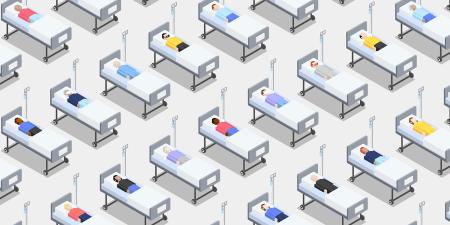Psychiatric conditions are leading causes of hospitalization across all age groups.1 Today, most acute psychiatric care is provided in an emergency department or other hospital setting. Strategies to prioritize patient and employee safety have been developed in response to suicides and other sentinel events in hospital settings,2 but efforts to reduce suicide, self-harm, and elopement are at odds with creating and maintaining therapeutic spaces. In this issue of the AMA Journal of Ethics, contributors explore what a psychiatric care site should look like, both in terms of its built environment and policies that shape caregivers’ work and individuals’ experiences.
Unlike past inpatient psychiatric settings, where some patients once stayed for months or years, inpatient psychiatric stays today are designed to be short. Many insurance plans limit how long inpatients can receive care, after which time they are generally discharged to outpatient or partial hospitalization settings. Lengths of stay began to decrease in the 1990s; after 1994, an average inpatient psychiatric stay in the United States was fewer than 10 days.3 Today, a primary goal of psychiatric inpatient hospital admission is acute crisis stabilization, for which patients’ conditions must meet criteria for their risk of harm to themselves or others.
Many patients admitted to psychiatric units are at high risk for suicide or self-harm, so safety is prioritized in the design of inpatient psychiatric units. The architecture of psychiatric care structures and spaces is guided by several sources, including national regulations (eg, the Joint Commission’s “Special Report: Suicide Prevention in Healthcare Settings”2) and individual organizations’ policies. Design requirements significantly influence the look and feel of psychiatric units4: door handles deter ligature attempts; furniture is bolted to a floor; doors contain anti-barricading features. Patients might be required to wear distinctly colored clothes, even on locked units, until they are deemed to not be at risk of absconding. Some recreational items (eg, books and exercise equipment) are deemed potential weapons and are thus prohibited.
This issue considers whether and to what extent well-intentioned design and policies can impede recovery, harm patients, or influence patients’ willingness to seek clinically indicated care.5 This issue also considers how tolerable risk levels ought to be determined and which design criteria could help prevent adverse outcomes without unjustly or unnecessarily limiting all patients’ freedoms. Contributors draw on cross-disciplinary research to consider ethical questions about designs of psychiatric care sites. By considering how to reduce risk while promoting healing, we hope to illuminate how more effective and supportive healing environments might be created for inpatients in psychiatric care settings.
References
-
McDermott KW, Elixhauser A, Sun R. Trends in hospital inpatient stays in the United States, 2005-2014. Agency for Healthcare Research and Quality; 2017. Healthcare Cost and Utilization Project statistical brief 225. Accessed April 25, 2023. https://hcup-us.ahrq.gov/reports/statbriefs/sb225-Inpatient-US-Stays-Trends.pdf
-
Special report: suicide prevention in health care settings. Jt Comm Perspect. 2017;37(11):1-7. Accessed November 28, 2023. https://www.jointcommission.org/-/media/tjc/documents/resources/patient-safety-topics/suicide-prevention/november_perspectives_suicide_risk_reduction.pdf
- Tulloch AD, Fearon P, David AS. Length of stay of general psychiatric inpatients in the United States: systematic review. Adm Policy Ment Health. 2011;38(3):155-168.
- Karlin BE, Zeiss RA. Best practices: environmental and therapeutic issues in psychiatric hospital design: toward best practices. Psychiatr Serv. 2006;57(10):1376-1378.
-
Jina-Pettersen N. Fear, neglect, coercion, and dehumanization: is inpatient psychiatric trauma contributing to a public health crisis? J Patient Exp. 2022;9:23743735221079138.



